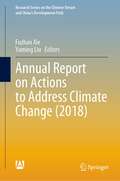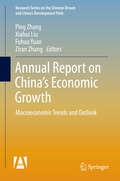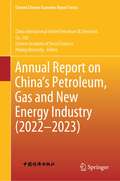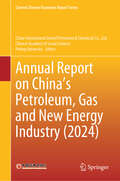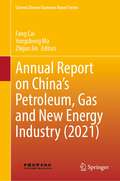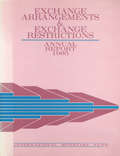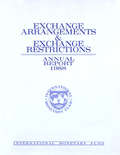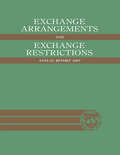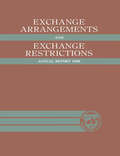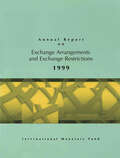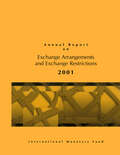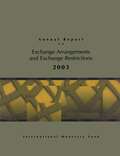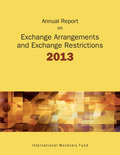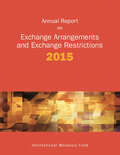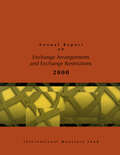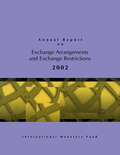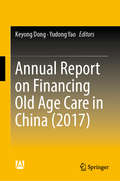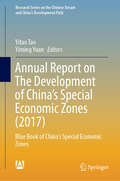- Table View
- List View
Annual Report of the Executive Directors for the Fiscal Year Ended April 30, 1962
by International Monetary FundA report from the International Monetary Fund.
Annual Report of the Executive Directors for the Fiscal Year Ended April 30, 1977
by International Monetary FundA report from the International Monetary Fund.
Annual Report on Actions to Address Climate Change (Research Series on the Chinese Dream and China’s Development Path)
by Yaming Liu Fuzhan XieThis book focuses on China’s efforts to address climate change on both the strategic and practical levels since the Katowice Climate Change Conference. Featured articles provide readers with both an overview and detailed discussions of topics such as assessment of low-carbon city development, building climate resilience, global climate governance, just transition, climate finance, and others. All the contributors are leading experts in the field from Research Institute for Eco-civilization (formerly Institute of Urban and Environmental Studies), Chinese Academy of Social Sciences, and China Meteorological Administration.
Annual Report on Actions to Address Climate Change: Climate Risk Prevention (Research Series on the Chinese Dream and China’s Development Path)
by Jiahua Pan Qingchen Chao Guiyang Zhuang Guoquan HuThis book highlights China’s theoretical advances and practical actions toward climate risk prevention in 2019. It provides both an overview and detailed discussion of specific topics, including case studies. The general report assesses the latest changes in the climate system both globally and in China, and identifies areas most susceptible to the impact of climate change. This is followed by topical reports on issues such as global climate governance, China’s strategy in climate negotiations, the carbon trade, climate insurance, domestic actions to address climate concerns, including specific solutions to local challenges and achievements made by cities in China. Written by top experts in the field from Research Institute for Eco-civilization of Chinese Academy of Social Sciences and National Climate Center of China Meteorological Administration, the book aims to inform the readers on recent development and progress in climate risk prevention.
Annual Report on China's Economic Growth: Macroeconomic Trends and Outlook (Research Series on the Chinese Dream and China’s Development Path #0)
by Ping Zhang Xiahui Liu Fuhua Yuan Ziran ZhangThis book probes into China's economic growth in 2013 and predicts China's development prospects. China's GDP growth in 2014 continues to slow down, and is expected to be 7. 6%, with the CPI stable at a level of 2. 5%. With the pressures of structural slowdown, 2014 will be a year of adjustment, and there will be a slowdown in new initiatives to minimize risk. Against a background of policies to stabilize growth, change structures and promote reforms, and in order to assess the sustainability of development and transformation and upgrade of China's provincial regions, this book proposes a system for evaluating the country's development prospects and expounds economic growth at the provincial level.
Annual Report on China’s Petroleum, Gas and New Energy Industry (Current Chinese Economic Report Series)
by Chinese Academy of Social Sciences China International United Petroleum & Chemicals Co., Ltd. Peking UniversityThis book focuses on the global economy, oil industry, natural gas industry, hydrogen energy industry, and electricity industry in China under the Carbon Emission Peak Strategy and the whole world. It provides the overview of the China's energy economy development in 2022–2023 and has an in-depth analysis of the future development trends of the oil and gas and new energy industries. It aims to present Chinese insights on the development of the energy industry of China and the world.
Annual Report on China’s Petroleum, Gas and New Energy Industry (Current Chinese Economic Report Series)
by Chinese Academy of Social Sciences China International United Petroleum & Chemicals Co., Ltd. Peking UniversityThis book provides a close analysis of the changes in the global oil and gas industry and the new energy industry. It offers a deep exploration of various sectors such as the global oil industry, natural gas industry, new energy industry, low-carbon market, and electricity market. Since 2023, there have been significant adjustments in the global energy market. The geopolitical situation in the Middle East is unstable, resulting in fluctuating international oil prices and a profound transformation in the trade flow of crude oil. Additionally, the global natural gas trade pattern is undergoing reshaping. China is accelerating the construction of a new energy system with the gradual increase in the proportion of renewable energy consumption, the development and improvement of the domestic carbon market, and the gradual expansion of green electricity trading. This book aims to provide a comprehensive overview and trend forecasts of the energy sectors for professional readers in the field, as well as to offer recommendations on how to respond to these developments.
Annual Report on China’s Petroleum, Gas and New Energy Industry (Current Chinese Economic Report Series)
by Yongsheng Ma Fang Cai Zhijun JinThis book focuses on the global economy, oil industry, natural gas industry, hydrogen energy industry, wind power industry, and low-carbon market in the post-pandemic era of China and the whole world. It provides the overview of the China's energy economy development in 2021 and has an in-depth analysis of the future development trends of the oil and gas and new energy industries. It aims to present Chinese insights on the development of the energy industry of China and the world.
Annual Report on China’s Response to Climate Change: Implementing The Paris Agreement (Research Series on the Chinese Dream and China’s Development Path)
by Weiguang Wang Yaming LiuThis book is written by experts from Institute of Urban and Environmental Studies of the Chinese Academy of Social Sciences, and National Climate Center, this book provides an overview of China’s effort to implement the Paris Agreement. In addition to measures put in place to reduce runoff in cities, improve flood risk management, promote decarbonization, and combat desertification, the book also addresses issues such as scientific assessment in relation to climate change, the implications of US domestic climate politics for China-US relations, and China’s emerging leadership role in the post-Paris age. The volume is a must-read for anybody who wants to understand how China’s aggressive climate adaptation policies help shape the country’s growing weight in global climate governance.
Annual Report on Exchange Arrangements And Exchange Restrictions:1985
by International Monetary FundA report from the International Monetary Fund.
Annual Report on Exchange Arrangements and Exchange Restrictions 1988
by International Monetary FundFinancial report from the IMF
Annual Report on Exchange Arrangements and Exchange Restrictions 1997 (Annual Report On Exchange Arrangements And Exchange Restrictions Ser. #1997)
by International Monetary FundA report from the International Monetary Fund.
Annual Report on Exchange Arrangements and Exchange Restrictions 1998 (Annual Report On Exchange Arrangements And Exchange Restrictions Ser. #1998)
by International Monetary FundA report from the International Monetary Fund.
Annual Report on Exchange Arrangements and Exchange Restrictions 1999 (Annual Report On Exchange Arrangements And Exchange Restrictions Ser. #1999)
by International Monetary FundA report from the International Monetary Fund.
Annual Report on Exchange Arrangements and Exchange Restrictions 2001 (Annual Report On Exchange Arrangements And Exchange Restrictions Ser. #2001)
by International Monetary FundA report from the International Monetary Fund.
Annual Report on Exchange Arrangements and Exchange Restrictions 2003 (Annual Report On Exchange Arrangements And Exchange Restrictions Ser. #2003)
by International Monetary FundA report from the International Monetary Fund.
Annual Report on Exchange Arrangements and Exchange Restrictions 2009
by International Monetary FundPublished since 1950, this authoritative, annual reference is based upon a unique IMF database that tracks exchange and trade arrangements for all 185 IMF member countries, along with Hong Kong SAR, Aruba, and the Netherlands Antilles. The Annual Report on Exchange Arrangements and Exchange Restrictions (AREAER) draws together information available to the IMF from a number of sources, including during official IMF staff visits to member countries. There is a separate chapter for each of the 187 countries included, and these are presented in a clear, easy-to-read tabular format. A summary table allows for simple cross-country comparisons of key features of their exchange and trade regimes. The report's introduction summarizes recent global trends and developments. It discusses such topical issues as exchange rate arrangements, current or capital transactions, or prudential regulations. The individual country chapters outline exchange measures in place, the structure and set
Annual Report on Exchange Arrangements and Exchange Restrictions 2015 (Annual Report On Exchange Arrangements And Exchange Restrictions Ser.)
by International Monetary FundA report from the International Monetary Fund.
Annual Report on Exchange Arrangements and Exchange Restrictions 2017
by International Monetary FundA report from the International Monetary Fund.
Annual Report on Exchange Arrangements and Exchange Restrictions, 2000 (Annual Report On Exchange Arrangements And Exchange Restrictions Ser. #2000)
by International Monetary FundA report from the International Monetary Fund.
Annual Report on Exchange Arrangements and Exchange Restrictions, 2002 (Annual Report On Exchange Arrangements And Exchange Restrictions Ser. #2002)
by International Monetary FundA report from the International Monetary Fund.
Annual Report on Exchange Arrangements and Exchange Restrictions, 2004 (Annual Report On Exchange Arrangements And Exchange Restrictions Ser. #2004)
by International Monetary FundA report from the International Monetary Fund.
Annual Report on Financing Old Age Care in China
by Yudong Yao Keyong DongThis book provides comprehensive analysis and descriptions of China’s ageing finance system . China is undergoing the largest, fastest and longest process of population ageing in the world. It becomes a pressing challenge to the Chinese social security system in this era. Many developed countries have been going through this process. Pension and other financial tools have been studied and practiced for decades. China now is developing its own ageing finance systems by learning from other countries’ experiences and making innovations to suit the country’s request. Finance, a field that deals with the study of investments and the science of money management, is the most important tool to manage this situation. And hence Ageing finance has been developed into an independent area for research and practice. It helps the country adapt to new elderly support systems which is the necessary result from China’s admirable economic development and changes in population structure. Ageing finance is the sum of financial activities centered on various social need of providing for the aged and serving for their society. It includes pension finance,old age wealth management service and finance of ageing industry.Chinese government and people are facing a very unique situation as our population structure is deeply changed by the One Child Policy since last 70s. The slope of ageing curve is sharper than most countries yet it has achieved the most successful economic development in the world during the same period. Academic researchers, financial practitioners, and policy makers will find this book to be essential reading, as they study this process and look forward to new theories, innovations and lessons raised from it.
Annual Report on The Development of China's Special Economic Zones: Blue Book of China's Special Economic Zones (Research Series on the Chinese Dream and China’s Development Path)
by Yitao Tao Yiming YuanThis Report objectively reflects the whole year’s progress of politics, economy, society, culture, system, environment, innovation and reform as well as the problems, challenges and countermeasures in traditional special economic zones and new special economic zones. It makes analysis of China’s Special Economic Zones, including overall review on the whole year’s development state of the reform experimental zone and part of new special economic zones, which focuses on analyzing the transformation of special economic zones, use of resources, the sustainable development, economic and social development, social security and technical innovation from the aspects of present situation of development, the comparative analysis, and policy suggestions and puts forward development suggestions for each specific issue.
Annual Report on The Development of PPP in China (Research Series on the Chinese Dream and China’s Development Path)
by Tianyi Wang Zhifeng Han Yongheng Yang Shouqing Wang Kaimeng LiThis book gathers invited top experts on Public-Private partnership (PPP) in China, from both theoretical and practical fields, to present the most comprehensive analyses of PPP’s practice in China up to 2017. This timely book offers researchers and practitioners a thorough understanding of the PPP’s development in China, including its definition, its modes, its features as well as its many kinds of applications into different industries including medical care, environmental protection, education, public works, park development, etc. It addresses diverse themes in PPP analyses such as quantitative analyses and qualitative analyses; data statistics and case study, theoretical framework modeling and field study verification. The book is an overview of the Chinese PPP development through 2017.


